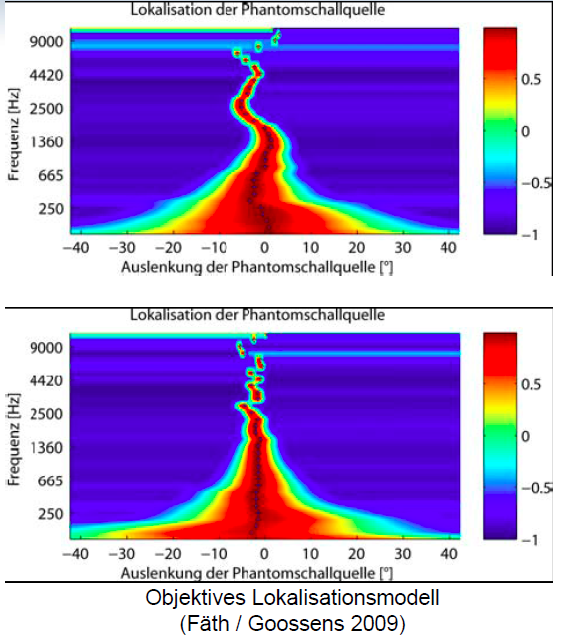POPS Position Of Phantom Source
Summing localisation of sterophonic phantom sources depends mainly on interaural differences : level (ILD) and time (ITD).
To "improve" monophonic sound, some researchers proposed pseudostereophonic systems, mainly with assymetrical all-pass filters on left and right, widening the stereo image and increase of apparent source width.
On the opposite, better loudspeaker and room symmetry (phase, level and frequency matching, toe-in,….), should improve perceived localisation : better source accuracy and stability, less position blur.
Can we objectively measure subjective localisation ?
I'm not searching for a complete auditory model to estimate true source position but rather for an indicator to compare localisation from various loudspeakers or configurations in rooms.
In the huge litterature on auditory localisation, I found only a few studies showing objective measurement of a phantom source :
- Perceptual differences between wavefield synthesis and stereophony by Helmut Wittek, see page 42 : frequency dependant IACC measurement http://www.google.fr/url?sa=t&rct=j&…44697112,d.ZWU
- Moglichkeiten und Grenzen der elektronishen Raumkorrektur bei Lautsprecherwiedergabe, Sebastian Goossens und Christian Gutmann, see page 15 : measure of groupdelay in lower frequencies, level differences at higher frequencies http://www.tonmeister.de/vdt/webdown…nberg_2011.pdf
From measured impulse responses, we can compute frequency related ILD and ITD and estimate perception of a "theoretically central" phantom source :
- azimuth angle : position, accuracy, stability
- source focus (no localization blur)
So I did a simple software to estimate localisation position computing ILD and ITD from impulse response measurements.
This soft is free (but works on windows only). It has a nice feature, the calculation is open : a GNU Octave script that everybody can modify and improve the pops.m octave file.
For now, the script does the following :
- frequency dependant windowing of the IR
- separate spectrum in third octave bands with a FIR filter
- calculate L/R IACC and level difference in each band
- compute localisation from both IACC and level (time intensity trading/adding)
Here microphone is moved to the right and the left of the central listening position :

Here mic is at the right and loudspeakers are not toe-in and toe-in (second image). The central phantom stays more central when speakers are crossed in front.

Left level decreased by 15dB and then by 8dB :

Mic at center position, L and R at normal distance and then L moved to front by 60cm :

Many remaining questions :
- can we really avoid measuring with an artificial head and simply work with L and R impulse responses ?
- is IACC + level enough or are there other parameters to add such as HF group delay, HRTF, binaural crosstalk,… ?
- what frequency filtering should better be used : gammatone, 1/6 octave,…
- how should ITD be calculated ? IACC, direct phase, groupdelay ?
- time/angle and level/angle are now linearly approximated : should this be changed ?
- should we also measure with non central phantom sources ?
- and the most important, does this analysis correlate to perception ? how to precisely check it ?

